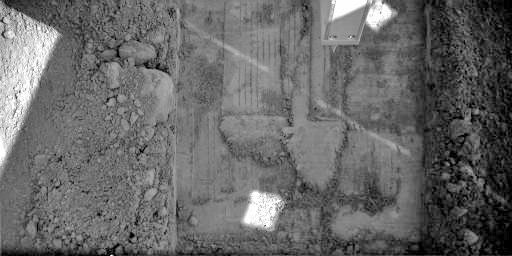Mars Lander Works on New Dirt Sample

NASA'sPhoenix Mars Lander delivered a second sample of Martian dirt to its onboardwet chemistry laboratory, NASA officials said Monday.
Data beamedback to Earth on Sunday night confirmed that Phoenix'srobotic arm had successfully delivered the sample to the instrument, whichtests the composition of the dirt by mixing it with water in one of fourteacup-sized beakers.
Resultsfrom testing this sample will be compared to results from the first sampleanalyzed by the wet chemistry laboratory two weeks ago. That laboratory is partof Phoenix's Microscopy, Electrochemistry and Conductivity Analyzer (MECA).
The resultsfor the firstwet chemistry test suggested that the Martian regolith contained severalsoluble minerals necessary for life, including potassium, magnesium andchloride.
The mainactivity on the lander's schedule for Monday was testing a method for scrapingup a sample of icy material and getting it into the scoop at the end of the roboticarm. On June 26, Phoenix scraped down to the subsurface icy layer in the "Wonderland"digging area and used a rasp to shaveoff some samples for later testing, but no material was actually in thescoop.
Phoenix will take images before, during andafter testing the sample scooping method to evaluate how well it works. If thetest goes well, the science team plans to use this method for gathering thenext sample to be delivered to the lander's Thermal and Evolved-Gas Analyzer(TEGA), which bakes samples and analyzes the vapors they give off.
A shortcircuit last month in one of TEGA's ovens could happen again when theinstrument is turned back on, so Phoenix mission scientists will treat the nextTEGA sample delivery as if it will be the last.
Get the Space.com Newsletter
Breaking space news, the latest updates on rocket launches, skywatching events and more!
The $420million mission landed on May 25 and is expected to operate for about threemonths (90 Martian days).
- Video: Digging on Mars
- Video: Phoenix, Rising to the Red Planet
- Images: Phoenix on Mars
Join our Space Forums to keep talking space on the latest missions, night sky and more! And if you have a news tip, correction or comment, let us know at: community@space.com.

Andrea Thompson is an associate editor at Scientific American, where she covers sustainability, energy and the environment. Prior to that, she was a senior writer covering climate science at Climate Central and a reporter and editor at Live Science, where she primarily covered Earth science and the environment. She holds a graduate degree in science health and environmental reporting from New York University, as well as a bachelor of science and and masters of science in atmospheric chemistry from the Georgia Institute of Technology.









